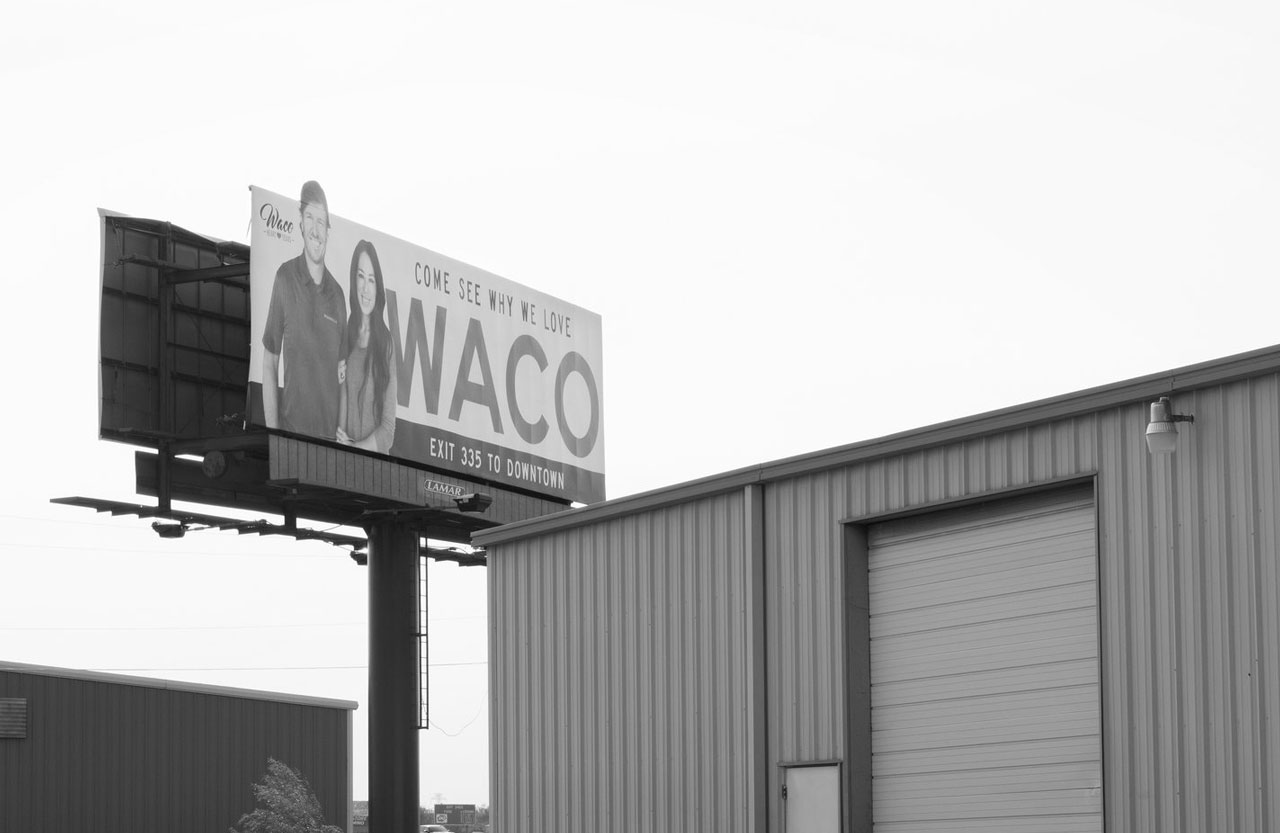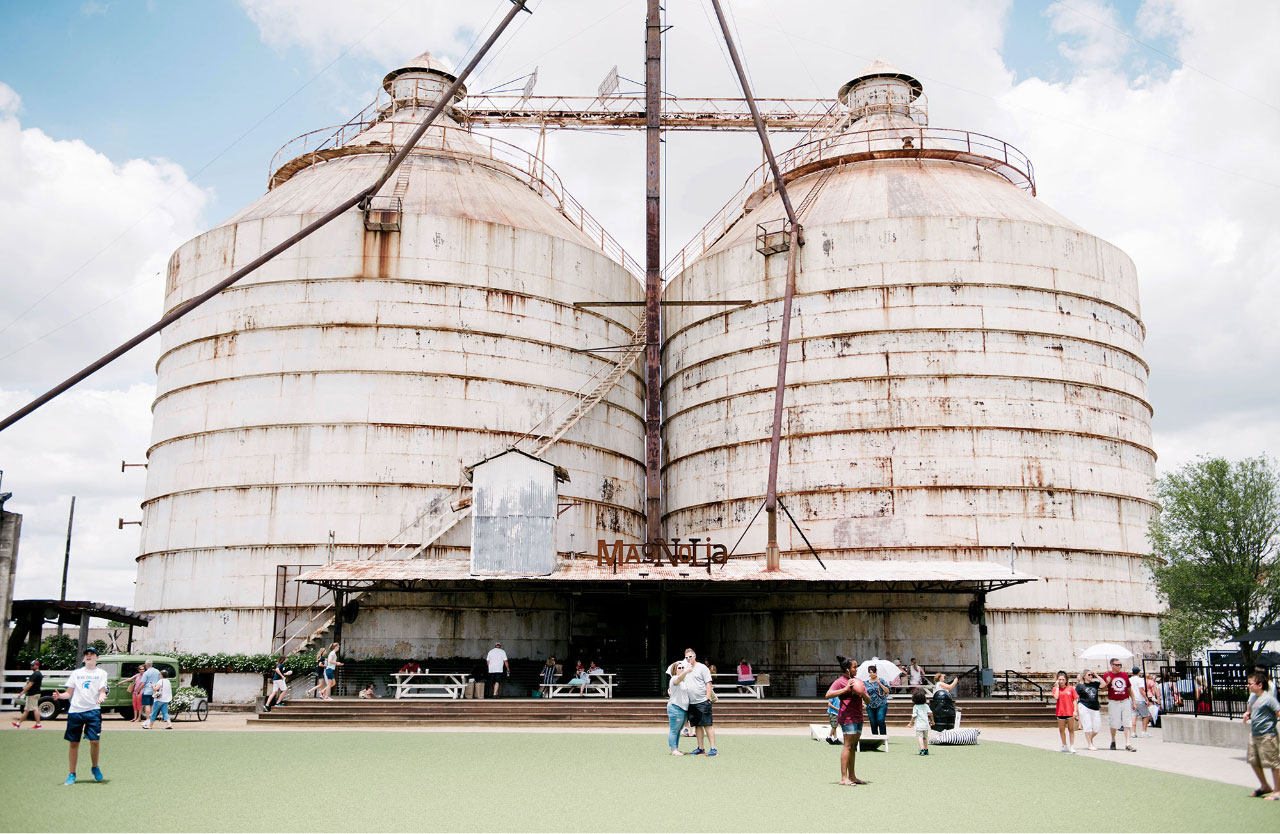

1. Welcome to The Silos
Chip and Joanna Gaines transformed Waco into a tourist hot spot by offering a much-needed face lift.
There are dozens of new stores in Waco, Texas, that sell the ingredients for a successful Instagram post. There are boutiques with cute linen rompers, well-lit coffee shops, and new shops with felt pennants stenciled with “Let Go and Let God” and hand towels screen-printed with “Alexa, please feed the kids.” And they’re almost all in the orbit of “the Silos” — two rust-stained containers, once filled with cotton seed, that serve as a shabby-chic navigation point from downtown Waco. “Close to the Silos” has become the most prominent characteristic in descriptions of Waco shops, real estate listings, hotels, and Airbnbs: “Within walking distance” means access to the spending dollars of the 50,000 (!) tourists who come to town every week.


Three and a half years ago, those silos were transformed by Chip and Joanna Gaines — the stars of the HGTV show Fixer Upper (2013–2018) and the couple behind the thriving Magnolia brand — into Waco’s new center of gravity. The real draw is 20,000 square feet of retail space, where you can buy Magnolia wreaths, Magnolia T-shirts (#SHIPLAP, Texas Forever), Magnolia Quarterly magazine (total audience: 5.6 million) and Chip and Jo’s five books, including Joanna’s cookbook, Magnolia Table, which quietly became one of the best-selling books of 2018. In the five years Fixer Upper aired, the Gaineses transitioned from running a modest local house-flipping business to overseeing a media, real estate and retail empire as nationally beloved celebrities; in Waco today, their influence is almost inescapable.


There’s a mini boutique in the Magnolia market selling an assortment of jewelry lines worn by Joanna onscreen, and “Chip’s Corner,” with hammers engraved with #DEMODAY — a reference to the mid-episode interlude of Fixer Upper when Chip releases some masculine energy by tearing down walls. Out back, a turf lawn is buttressed by food trucks selling “gourmet grilled cheese,” “trashcan rice bowls,” and blended watermelon juice served in a “personal-sized watermelon,” described on the Magnolia website as “one of the most ‘Instagrammable’ items at the Silos.”
“...The Gaineses transitioned from running a modest local house-flipping business to overseeing a media, real estate and retail empire as nationally beloved celebrities; in Waco today, their influence is almost inescapable.”
But the Silos are only the beginning. With its diner, auxiliary bargain shop, sprawling real estate business, and video production operation, months, the company purchased a CrossFit gym (which the Gaineses plan to turn into a coffee shop), a museum set in a historical home, and a 6,700-square-foot stone castle, adding to recent purchases of the 53,000-square-foot Karem Shrine Building and the Second Presbyterian Church. All of these are potential fodder and sets for the Gaineses’ newly announced television network, which promises hours of Magnolia branded content: on relationships, parenting, cooking, and, of course, fixing up.
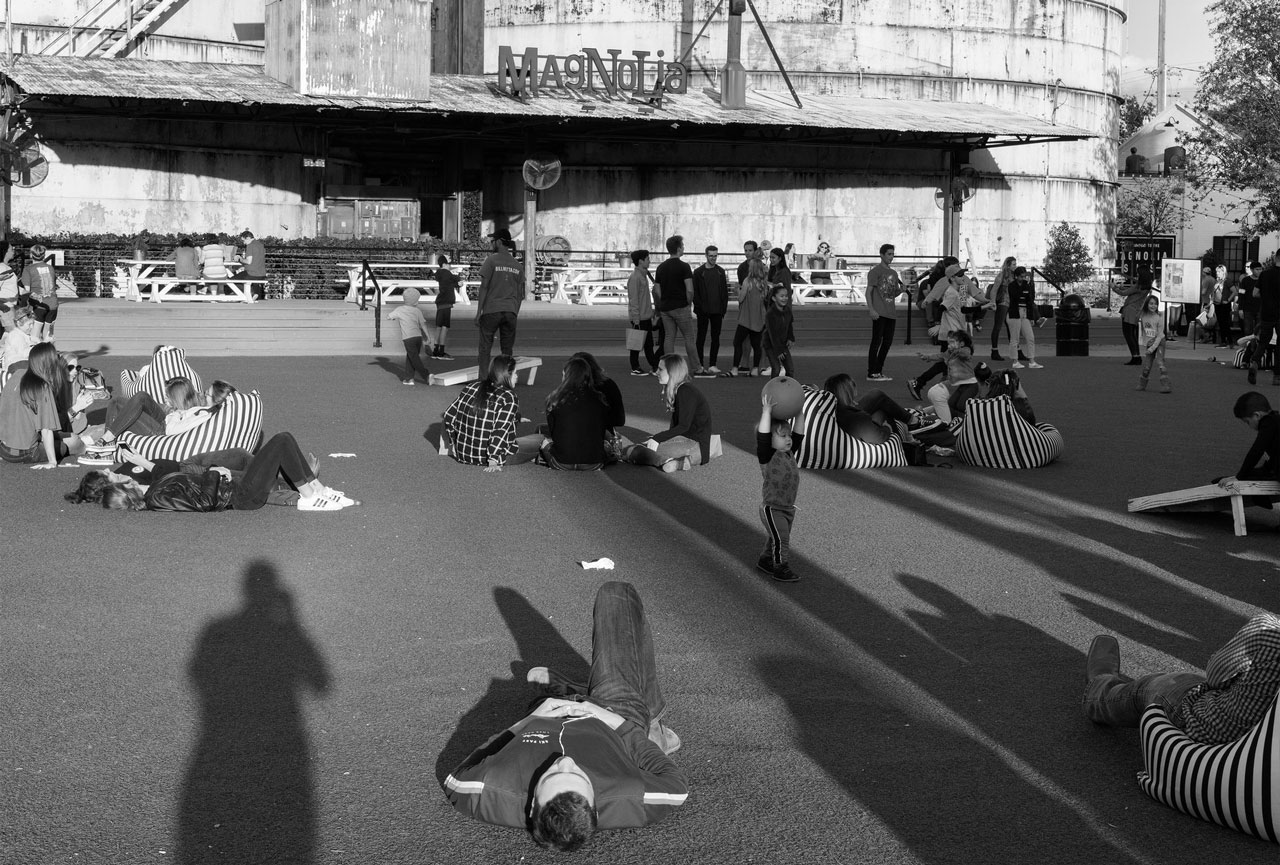

2. The "Magnolia Effect"
The community responds to its new found identity post Fixer-Upper.
Like so many small cities across America, Waco had lost its downtown core and the economic vibrancy that once accompanied it. (Unlike most small cities, the process had been catalyzed by a 1953 tornado that killed 114 people and razed 196 buildings.) And in the ’90s, it lost its reputation to the deadly 1993 standoff between federal agents and Branch Davidian cult leader David Koresh, who had established a compound near town. As the two-person engine of an entire small industry and economic boom, the Gaineses have cleaved history in two: Before Chip and Jo, and After. The Old Waco, and the New.
“People would see all these incredibly likable Waco families on the show,” Waco City Council Rep. Dillon Meek told me. “And they’d say, well, they don’t look like they’re in a cult, and that family doesn’t look like they’re in a cult.” Longtime residents complain a bit about the parking and a lot about the rising property taxes, but everyone seems to agree that forgetting the Branch Davidians is great, and the new restaurants and shops, the places that make your extended family actually want to come visit you — that’s all great. “When I used to tell people where I was from, they’d say, ‘Oh, I’m sorry,’” another former resident told me. “Now they say, oh my god, Magnolia!”
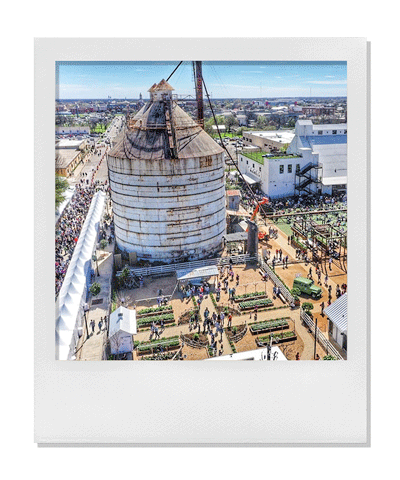
While that phenomenon is broadly referred to as the “Fixer Upper effect” or “Magnolia effect,” it goes far beyond Chip and Joanna. In many ways, the story of Waco is an old-fashioned story of a company town, where the university (Baylor), the biggest church in town (Antioch Community Church, where the Gaineses are members), and one of the biggest businesses (Magnolia) largely dictate how — and through whom — power and prosperity spread and reproduce. And like any town in the throes of transition, there’s a part of Waco that’s wary of promises of salvation if it means sacrificing ownership, literal and figurative, of the community — and handing over control to those who’ve historically demonstrated little interest in preserving that community.

In January, the owner of a brake repair shop a block from the Silos threw in the towel, selling his two buildings to an antiques dealer for an undisclosed sum. “Nobody could get to us for the traffic,” he said. “Our typical customer is a 60-year-old farmer pulling a trailer.”
“As the two-person engine of an entire small industry and economic boom, the Gaineses have cleaved history in two: Before Chip and Jo, and After. The Old Waco, and the New.”
And some of the changes happening in town, and the attitudes driving them, have raised hackles. “You’re not saving a neighborhood because you got there,” a longtime resident told me. “Just because it’s not what you lived in, doesn’t mean it’s worse, or bad.”
There is, after all, a Waco that you don’t see on Fixer Upper — a Waco that’s over 21% black, over 32% Latino, and where 26.8% of the city lives beneath the poverty line. To some, the Magnolia effect is not just transforming houses and vacant brick storefronts, but smoothing and sanding the actual diversity of town, painting everything slightly different shades of white. Everyone’s invited to the Restoration of Waco. But what if, despite the invitation, you still don’t feel welcome?
The allure of Fixer Upper, which Chip and Joanna decided to stop filming in 2017, was built on a handful of fantasies — having a partner who’s handy; having the financial and psychological wherewithal to redesign a house — but the most irresistible fantasy might be the affordable home prices. We’re talking four-bedroom houses for less than $100,000 — sometimes significantly less. If you don’t live in an urban area where home ownership has become untenable, it might be difficult to understand just how appealing a prospect that is. In Waco, a regular person working a regular job can afford to own a regular home. Not a 500-square-foot apartment, not a Volkswagen van, but a house — with a yard.
“I never thought we would live in Waco — ever, ever. It was just a stopover on the way up and down I-35,” one woman, who had recently moved from the Austin suburbs with her family, told me. “It’s reverting to what we knew growing up,” she said. “It’s quiet, it’s got this beautiful pace of life. We have raised beds in the garden, and you can see the stars at night.”
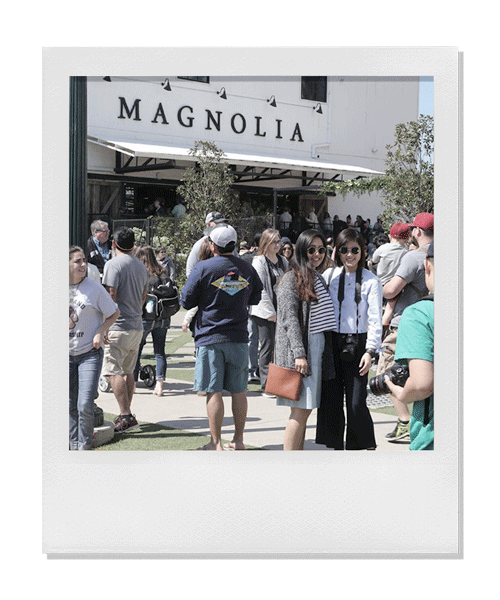
In the five days I spent in Waco, I found myself stymied by the thought: Do I love this? Do I hate this? Or do I just resent how effectively I’m being marketed to? As a white, middle-class woman, it’s difficult to shake the feeling, walking from shop to shop, of being haunted by the physical manifestation of a targeted Instagram ad. But there’s something about Chip and Joanna Gaines — and, by extension, the changes they’ve helped catalyze in Waco — that tends to disarm cynicism.

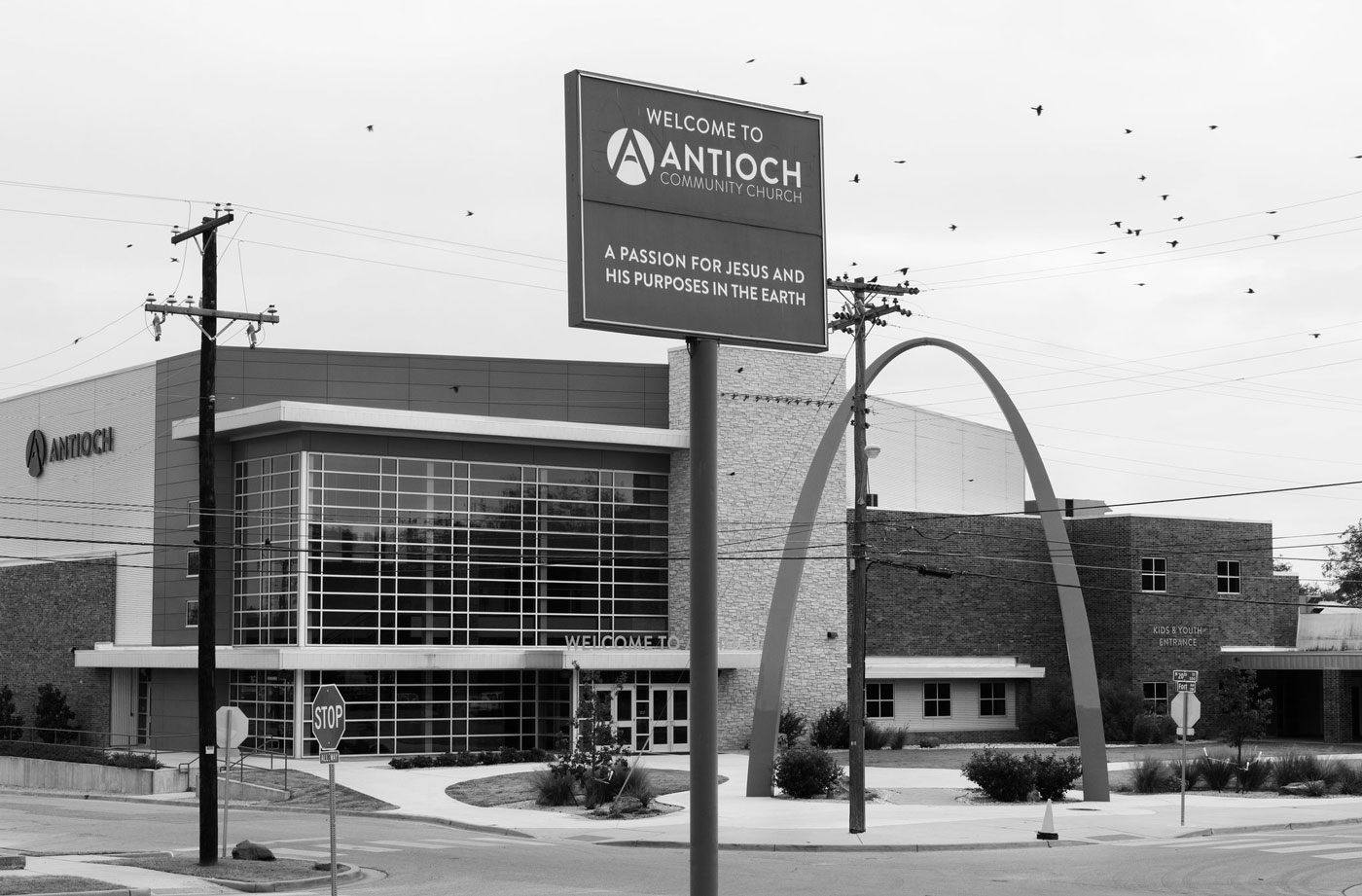

3. Antioch Community Church
The separation of Antioch Community Church and Waco became indistinguishable as the church's influence increased.
Joanna is a working mother and the face of the Magnolia brand, but the family’s vibe remains traditional — which is also part of what Christian faith, which they profess without hitting people over the head with it. They’ve both shared their testimonies multiple times — a video of Joanna’s, released in 2015, has been viewed over 5.8 million times. But they also minister through their presence. If you admire Chip and Jo, and are curious about what makes their lives work, then that curiosity might also lead you to Jesus.
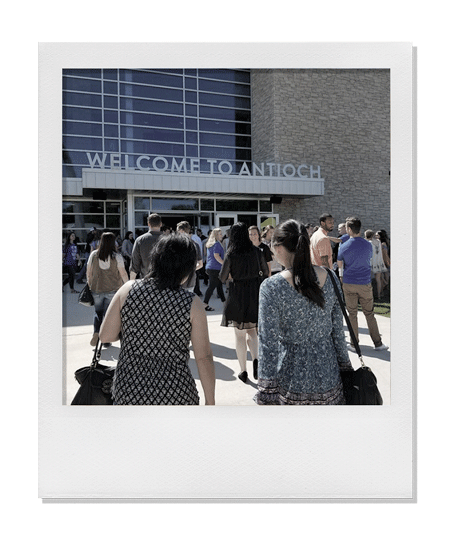
That particular style of proselytizing typifies the work of Antioch Community Church, whose 5,000-plus-person congregation includes the Gaines family as well as a far-reaching constellation of Magnolia employees, Fixer Upper alumni,and local leaders. (There’s another Antioch in Waco with a predominantly black congregation, founded in 1896. “People talk about Antioch Community like it’s the only Antioch that ever was,” one woman told me. “But Antioch Baptist has been around.”)
In the late 1990s, the younger Antioch split from Highland Baptist Church, one of the major Baptist churches in town. “The people who chose to stay were the more traditional families,” one person, who was a Highland member at the time, told me, “while Antioch always felt young and, like, sexy.” Based on the service I attended, the congregation is also majority, but certainly not entirely, white.
In the very beginning, Antioch was meeting in a parking lot, baptizing people in a horse trough. In time, the church moved from the parking lot to an old H-E-B grocery store in North Waco — an area familiar to viewers of Fixer Upper as the site of many of Chip and Jo’s house flips. The H-E-B provided an affordable landing spot for Antioch’s fledgling congregation, but North Waco also fit the church’s mission: to minister to the nation and “the nations.”
A century ago, North Waco was the “suburbs,” but the combination of white flight from the urban core and the closure of a major hospital did what it always does: The housing prices dropped. The schools got worse. Crime levels rose. As the percentage of rentals increased, so did the percentage of absentee landlords. That’s how an area of town earns a reputation, at least among residents who’ve moved away, as a place you don’t go — or at least a place that’s not worth going to. When describing the areas of town, one former Waco resident caught himself describing North Waco as “empty.” “I realized I used that word,” he said, “but these are places that are actually populated.” Just not populated by bourgeois white people.
“The church’s plan was to move into the neighborhood and “love on them and minister to them...”
The church’s plan was to move into the neighborhood and “love on them and minister to them,” as one former Antioch member put it. Or, as Antioch’s website explains, “we plant churches and impact communities with God’s love that we might see His Kingdom come and His Will be done.” The pastoral staff moved to North Waco near the church, and dozens of others followed. Over the last 20 years, the church has continued to buy more property in the area, including houses that they converted into addiction recovery homes.

When Antioch first began expanding in Waco, a former member told me, “it was really a 1980s version of evangelism — like, ‘beach reach,’ street preaching, and door-knocking to ask ‘Do you know Jesus?’” Gradually, Antioch realized that approach made members seem like a bunch of “Jesus freaks,” as the canonical ’90s DC Talk song put it. So they switched gears.
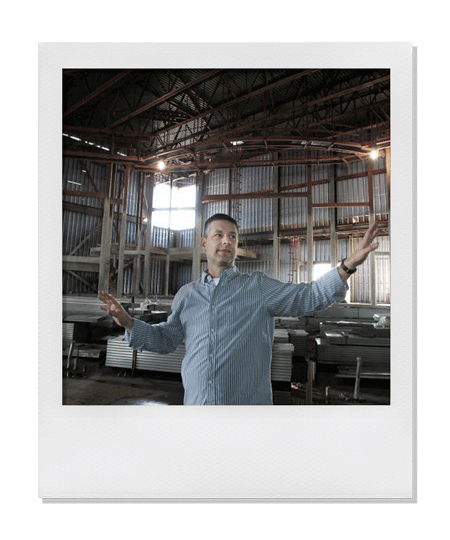
“They just decided to own Waco instead,” the member told me. “All of the weird evangelizing, it went away. They all became ambitious entrepreneurs. They employed each other. They developed a monopoly on the upwardly mobile class of Waco. If you want[ed] to rise through the social and economic ranks, the only way to do it was through the church.”
Over the last 20 years, Antioch has also expanded its reach far beyond Waco, with 28 churches “planted” across the United States, and 80 “teams” in 40 countries across the world. Today, the old H-E-B serves “as the church’s auxiliary building, and services are held in a newly built auditorium that seats 5,000. Its local mission, Impact Waco, works to boost reading scores in elementary students, and ministers to “victims of human trafficking” and men and women dealing with addiction.
Like many religious organizations, there’s a spectrum of involvement; several former members described it to me as similar, in structure, to an MLM, with spiritual incentives and social pressure to invest more time and money (in “Life Groups,” in discipleship school, and, eventually, on overseas missions) while always recruiting more members to “disciple.” Over email, Senior Pastor Jimmy Seibert told me, “For 2000 years, discipleship has been the primary way the church worldwide has grown and multiplied. Our church is committed to investing in people and teaching the Bible as the word of God and encouraging each person to invest in others’ lives.”
“A psychologist in town meets regularly with a group of self-described 'Antioch survivors.'”
“There’s some abuse of the culture of authority,” the wife of a former Antioch member told me. “People who say, ‘I don’t think you’re dating the right girl, and I’m your leader, and you need to listen to me.’ But those are college students making those proclamations.” A psychologist in town meets regularly with a group of self-described “Antioch survivors.” Former members told me stories of crises of faith after being made to feel unwelcome by the church, either for life decisions (declining to go on a mission) or for their identity (coming out as gay).

"Love the Sinner, Hate the Sin"
Following the Supreme Court ruling on same-sex marriage in 2015, Seibert, who is Antioch’s lead pastor, reaffirmed the church’s belief that homosexuality is a sin, suggesting that 90% of people in a same- sex relationship were “abused in some way.” Seibert advised local business owners not to soften their stances toward homosexuality, praising those “willing to stand to lose even a deal or two or ten or even lose their business.”
A BIBLICAL RESPONSE TO THE SUPREME COURT DECISION ON SAME-SEX MARRIAGE
Jimmy Seibert, founder of Antioch Community Church
Senior Pastor Jimmy Seibert addresses the Supreme Court decision regarding same-sex marriage last Friday from a Biblical perspective. He offers both clarity and compassion regarding the decision and the issue of homosexuality and encourages the Church to respond according to God’s Word. We are called to be rescuers; to speak the truth in love and to help people go to God and His word for whatever issues we face as a culture.
In 2016, a BuzzFeed News article highlighted the connection between Antioch and Fixer Upper, and fans of Chip and Joanna expressed outrage at the suggestion that they should be associated with or asked to address their church’s stated position on same-sex relationships. After two days, the HGTV network issued a statement: “We don’t discriminate against the LGBT community in any of our shows.” The Gaineses didn’t comment at the time, but a little over a month later, Chip published a blog post on the Magnolia website titled “Chip’s New Year’s Revelation,” which reads in part:
If there is any hope for all of us to move forward, to heal and to grow — we have got to learn to engage people who are different from us with dignity and with love. Joanna and I have personal convictions. One of them is this: we care about you for the simple fact that you are a person, our neighbor on planet earth. It’s not about what color your skin is, how much money you have in the bank, your political affiliation, sexual orientation, gender, nationality or faith.
Based on my conversations with others in town, the belief that homosexuality is a sin — and a pathological one at that — is common across Waco’s Christian community. “When the LGBT thing became a scandal, I found it so weird,” a woman who grew up in Waco told me. “That’s like 80% of the churches in Waco! It’s nothing new.”
“It’s not easy to be a queer person in Waco,” Charley Garrison, the openly gay pastor of Central Texas Metropolitan Community Church, told me. “People here use phrases like ‘homosexual lifestyle’ and ‘love the sinner, hate the sin,’ which, blegh.” When I attended an Antioch service in March, “healing” from a “homosexual lifestyle” was mentioned twice during the 90-minute service.
“It’s not easy to be a queer person in Waco,” Charley Garrison, the openly gay pastor of Central Texas Metropolitan Community Church, told me. “People here use phrases like ‘homosexual lifestyle’ and ‘love the sinner, hate the sin,’ which, blegh.” When I attended an Antioch service in March, “healing” from a “homosexual lifestyle” was mentioned twice during the 90-minute service.
There’s a real and compelling rhetoric of welcome in Waco: Come be a part of our community, come spend your tourist dollars, come appreciate all the New Waco has to offer. But that welcome, at least in practice, has limits. In 2016, the county decided there was “no need” for its nondiscrimination policy to include gender identity and sexual orientation; one of the two local justices of the peace who perform courthouse weddings still refuses to perform them for sex-same couples. But Garrison will. “I think to myself, Your own pastor won’t marry you. Why do you go there? That’s just how strong culture and religion can be.”
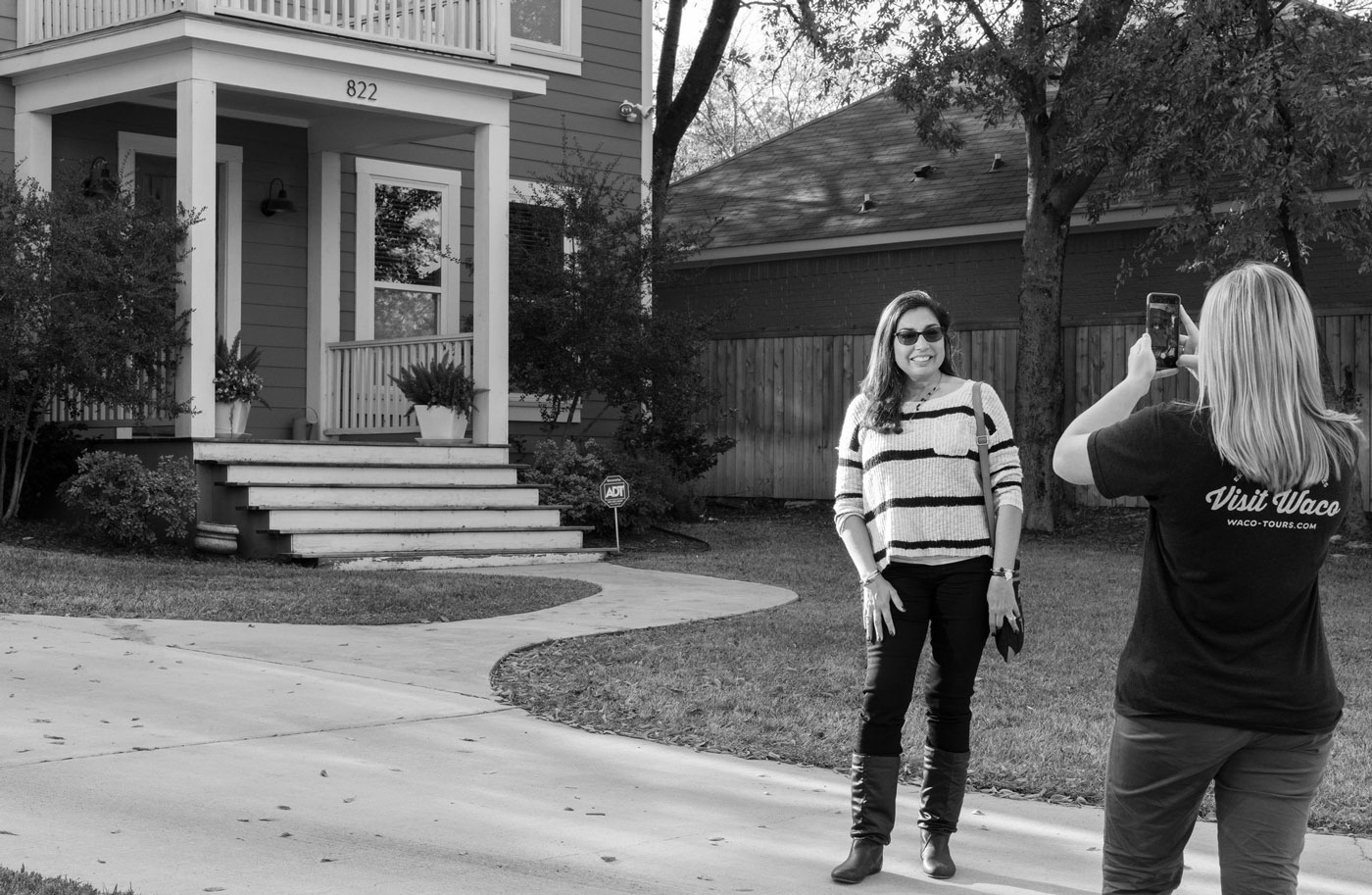

4. Fixer Upper “Gone Bad”
Does fixing a small city mean removing its diversity?
As Antioch’s presence continued to spread through North Waco, so did Fixer Upper’s. In Season 1, Chip and Joanna transformed a $10,000 house — referred to, at various points, as “a drug dealer’s house” and a “crime scene” — into a gleaming, six-bedroom home. “The Beast,” as the project was nicknamed, was chosen by the Harps, who owned the now-famous carpentry shop next door where Joanna custom-orders islands, doors, and other reclaimed wood objects featured on the show.
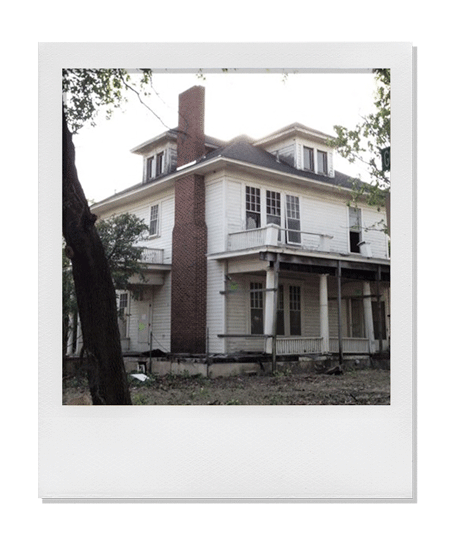
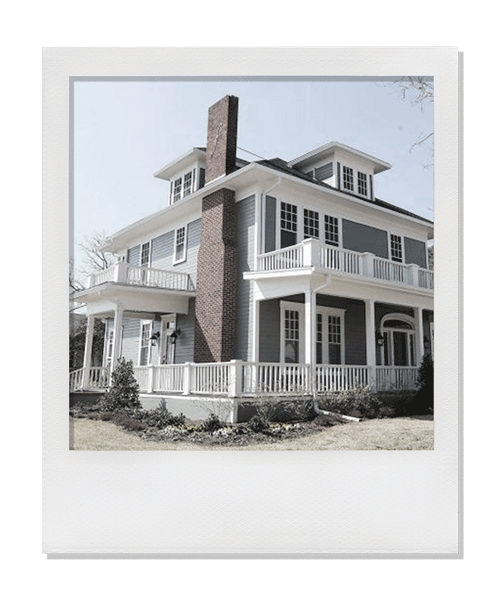
Today, you can rent the rechristened “Harp House” on Airbnb for $550 a night — and a stream of tour buses stop by Harp Design Co. every hour, on the hour, to browse reclaimed wood carpentry and $10 resin birds. On a Thursday afternoon, a neighborhood man sat on the stairs leading up to the Harp shop, greeting visitors with a “God bless” and a request for spare change. Just feet away, a tour guide struggled to frame a photograph of four women with spiky mom cuts in front of the Harp sign, without the man in it.
“We have been intimidated and harassed,” the owner said. 'People have complained about their taxes going up because we moved here.'”
The Magnolia effect has brought other tensions to North Waco — both for those who’ve been living in the neighborhood for years and for newer transplants. In 2017, a suspected drunk driver smashed through the front of the “Three Little Pigs” house from Season 3 of Fixer Upper. The homeowners told the Waco Tribune that they felt they had been “deceived” by Magnolia Realty, the Gaines-owned real estate business that handles many of the transactions on the show. They did not expect “late-night noise from nearby bars, suspicious activity and pushback, some of it anti-Fixer Upper,” from local residents when they complained to police.
“We have been intimidated and harassed,” the owner said. “People have complained about their taxes going up because we moved here.” (Over the last four years, property taxes have indeed skyrocketed — up, year after year, between 10% and 40%.) “There’s a big problem here,” the owner said. “It’s not safe. This is Fixer Upper gone bad.”
“There’s this prevailing perception of North Waco that’s not accurate,” Diamante Maya, who’s lived in the neighborhood for the last decade, told me. “When I first came to Baylor, professors told me not to move here. And sure, it’s got some dilapidated houses, and African American people and people who only speak Spanish. And people see low income and diversity and associate it with crime. But that’s not what I’ve experienced.”
In 1986, Joe Gatlin — who grew up in North Waco — moved back to the area with his wife, Nancy, to launch the local Habitat for Humanity. Everyone, he recalls, assumed they’d be moving to the suburbs. “But we wanted a neighborhood where there’s pedestrian traffic, where people are speaking Spanish, where people gravitate towards their front yards instead of their backyards,” he said.
That was North Waco then — and to a very large extent, even with the growth of Antioch and Fixer Upper, it still is North Waco now. “Some people move into a neighborhood with that idea of ‘We’re gonna fix things, we’re gonna turn everyone into middle-class people, and then they’ll look or act like us,’” Gatlin said. Habitat, especially at that time, was different: “You empower through home ownership. The reason we moved to North Waco was that we thought, This is the best place to live.”
According to Grassroots Community Development, the home ownership rate in North Waco has increased from 38% to 43% over the last 16 years. A city grant has helped fund repairs for code violations — which means that more problems are reported and remedied before houses sink into dilapidation. The 25th Street corridor has become an incubator for Latino-owned businesses. Though when Antioch and a “rush” of congregants first moved in, in the late ’90s, Gatlin admits he was concerned. “I thought, Oh man, this is really gonna swing us in a bad direction.” He says that he looks at the population on the streets, and it still seems very diverse — at least for now. But recent gentrification, which has caused steadily rising property taxes, is having a real effect on the community.
“Everyone is just getting zinged,” Gatlin said. “This has been happening for four years — and it’s gonna have some real ramifications for our neighborhood, when people living on these slim margins just can’t afford the taxes.” Unless, of course, your home has been fixer-uppered — or rehabbed by Antioch or its members.


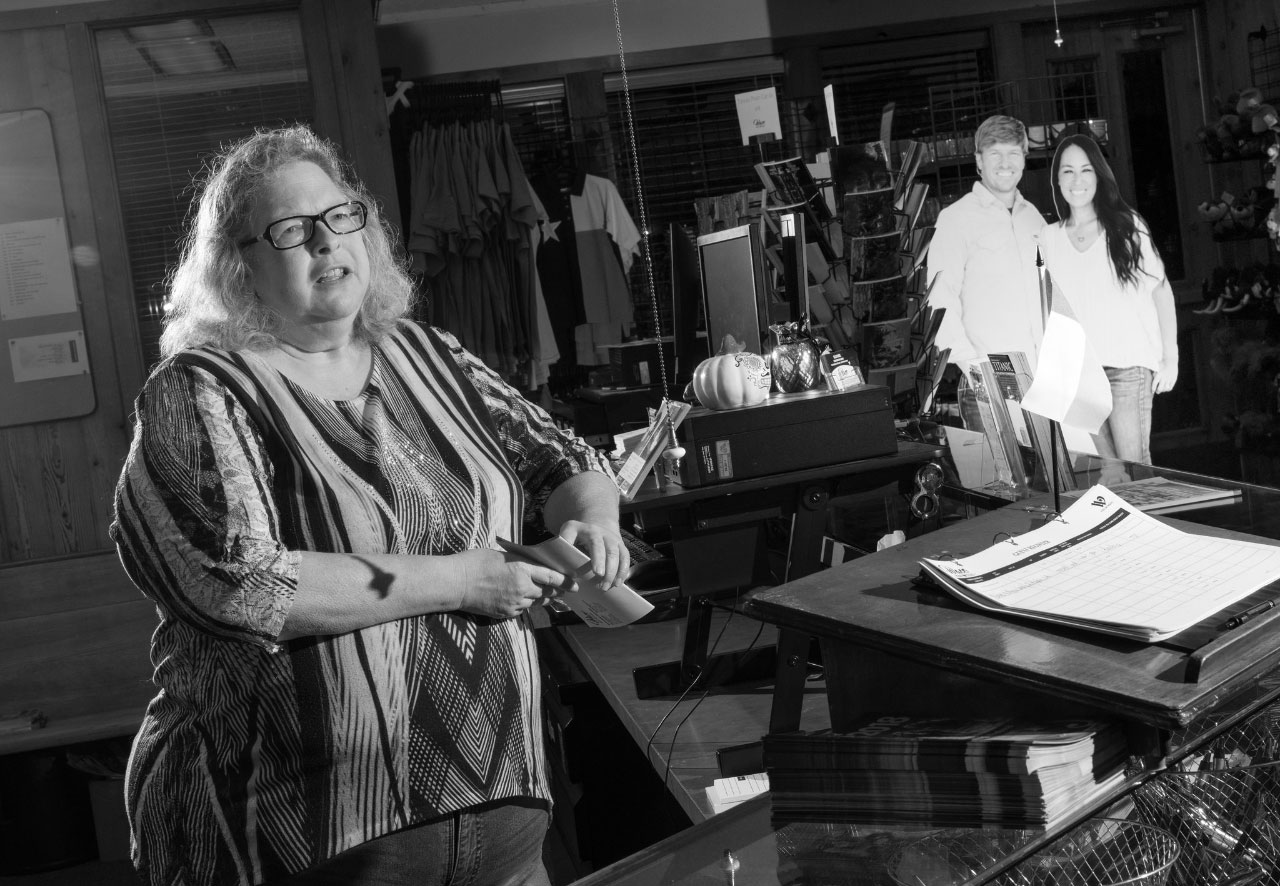

5. A Tour of Waco’s “Restoration”
“God is blessing Waco.”
For $79, you can get a 2.5-hour tour of Waco, plus an ice cream cone, a Dr Pepper, and a Waco Tours koozie. When I went online to book a Friday tour, nearly all of the timeslots were sold out. I got a ticket for 3 p.m., and was joined by a husband who had surprised his wife on their anniversary by arranging a trip from Salt Lake City, and a grandma, mom, and daughter from Arkansas. There was our cheery driver, who’d retired to Waco with his wife on a whim after driving through. And there was our guide, Chase, who’d settled in Waco after a four- year mission in Nepal, and led tours on his day off from serving as a youth pastor at Antioch.
Pastor Chase asked us if it was okay to start the tour with a prayer. It was, so he blessed us, and the tour, and Waco, and we went on our way: winding through the streets of downtown as he described the founding of the town, the destruction of the 1953 tornado, the rehabilitation of the Silos. Outside his pop-up shop, metalworker Jimmy Don — who makes all the engraved message signs for Fixer Upper — hopped into the van and posed for a selfie. “The theme of the city of Waco is ‘restoration,’” Chase said.
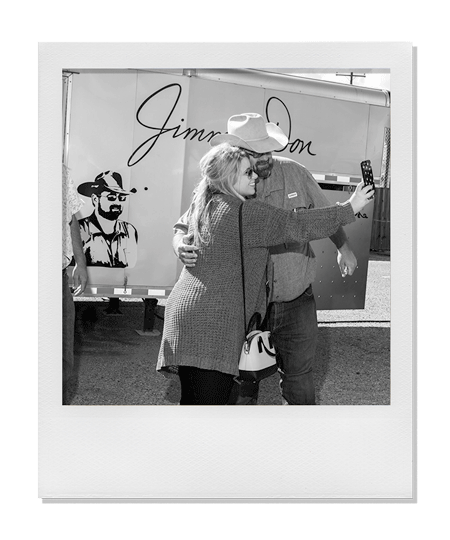
The restorative natural springs of Waco drew (white) people to the area in the 20th century, Chase explained. But the tour itself is evidence of the latest restoration: of homes, of course, but also of Waco as a whole. What goes unsaid, at least on the tour, is the centrality of “restoration” to evangelism. The evangelical movement “I Am Second,” whose website is filled with testimonials from prominent Christians, including the Gaineses, describes its mission as “Restoration. The world as it was meant to be. People redeemed and lives transformed.”
That’s how Antioch seems to see Waco: turning, however slowly, into “the world as it was meant to be.” “Waco doesn’t only hold an expectation for physical healing,” an Antioch blog post explains. “It also poised itself to be a place for people to find restoration and life in Jesus.”
“Waco doesn’t only hold an expectation for physical healing,” an Antioch blog post explains. “It also poised itself to be a place for people to find restoration and life in Jesus.”
As our van meandered through Baylor, Chase described the campus in glowing rhetoric that would rival the admissions office. There’s a lot to describe: Baylor’s expansion over the past two decades — alongside Antioch and, later, Magnolia — has been one of the driving forces behind the changes happening in Waco.

Baylor University
For most of the 20th century, Baylor University resembled many other religious colleges of its size: intimate class size, relatively affordable, with a largely in-state student body. It was the place that well-to-do Texas families, especially Baptist ones, sent their kids for a solid, private, faith-based education. At least, that is, white families did. Baylor didn’t accept its first black student until 1964. Baylor slowly coming to terms with its identity as an integrated college was the first of multiple “schisms” among the administration and the faculty as to the college’s future. Catholic universities — Notre Dame, Boston College, Gonzaga — had figured out how to tread the line between academic excellence and religious rigor. But there was no established Protestant model, and every president, every faculty has to figure out the balance.
Over the years the administration has made a concerted effort to turn the school into an “R-1” school — meaning the top tier of larger research universities — and between 2002 and 2012, the school spent nearly $400 million on new construction and renovations, and authorized $120 million more. In 2010, former solicitor general Ken Starr was brought in as university president to bring in the cash to fund the expansion. In 2012, construction began on a $260 million football stadium. Baylor was trading its small Bible college image in for a new one: the Notre Dame of the South.
Today, Baylor is a sports powerhouse — but that growth has had some unexpected ramifications. In 2014, a star football recruit was indicted for (and later convicted of) sexually assaulting a fellow student, an incident that wasn’t covered up, per se, so much as kept very, very quiet. In the aftermath, most people in Waco — including Chip and Joanna Gaines — have been eager to leave the scandal behind, but it’s still unclear if the “cultural perception that football was above the rules” at Baylor, as the university’s external review described it, has truly changed. Like so many schools, football has become essential to Baylor’s lifeblood. And Baylor’s lifeblood is Waco’s lifeblood.
For many, the continued decimation of Waco’s downtown over the next few decades was no big loss. Many white, well-off citizens had already moved to the suburbs, returning only for church or Baylor events — a pattern that continued well into the 2000s. But there were ramifications for the communities that remained: Cameron Park — once the pride of the city — became a place where Baylor students were told to never go. Across the Brazos River, East Waco lost its economic engine when the historically black Paul Quinn College relocated to Dallas in 1990. Multiple people told me stories of being discouraged — by family, by Baylor faculty — from considering living anywhere other than the suburbs.
City Council Rep. Andrea Jackson Barefield told me that during that time, “a whole generation of black excellence” left Waco. “My parents, middle-class parents, they told us: 'Go be great,'” she said. “Operative world: Go. When our parents grew old, we didn’t want to move back — or take care of the houses we inherited.” (Some, like Andrea’s mother, Mae, did take action: She moved back into East Waco, and, in 2004, became the first black woman to be elected mayor of Waco.)
For decades, Baylor didn’t need to be connected to downtown or East Waco — or, in truth, anything other than the interstate. But that began to change in 2012, when Baylor announced the new football stadium, which would be built in the one place with enough vacant, cheap land, within walking distance to Baylor: just across the river, in East Waco. Two years later, the opening of the Silos, located at the perfect midway point between Baylor and downtown, reconnected the dots — and sparked a wave of development that dwarfed all that had come before.
Ending the Tour with a Blessing
As we drove into North Waco, the tour stopped outside the only Fixer Upper home ever fixed up for a bachelor — an ex-model who found Jesus and Antioch, and, in 2017, opened Waco Tours, which he now co- owns with Antioch’s college pastor. A short drive away, Chase pointed out the new grocery store, launched by Mission Waco and funded by the Gaineses, and Laverty’s, the antiques store that was about to go out of business until Joanna started going there on camera. And then, just around the corner, there was Antioch.
There was no explicit invitation to come to church on Sunday, as Chase told us the story of Antioch. Rather, there was just Chase’s inviting youth pastor energy, this evidence of restoration, and the message that what Waco looks like today is Antioch and Baylor and Magnolia’s work, which is to say, God’s work. As one of dozens of glowing TripAdvisor reviews for Waco Tours put it, “Learning the history, seeing some of the Fixer Upper homes, and to see how Waco is being restored, from the ashes of a devastating tornado...I believe that through prayer, God is blessing Waco.”
“Different people are going to have different ideas of what a ‘restored neighborhood’ means,” he said. “I’m not a theocrat, but for me, restoration starts in my faith.” For Meek, Antioch, Mission Waco, and Hope Fellowship — all of which have moved, intentionally, into North Waco — have provided “a beautiful image of building diversity in neighborhoods slowly over time,” he said. “Buying homes, building a relationship with the neighborhood — it’s way better than building a high-rise.”
Towns like Waco have long been steered by religious leaders; that’s not anything new. What’s new is how integral the Antioch vision is to so much of the business and real estate development happening now, in which Christian entrepreneurs, as “pioneer-spirits,” map a course for Waco as if settling it for the first time.
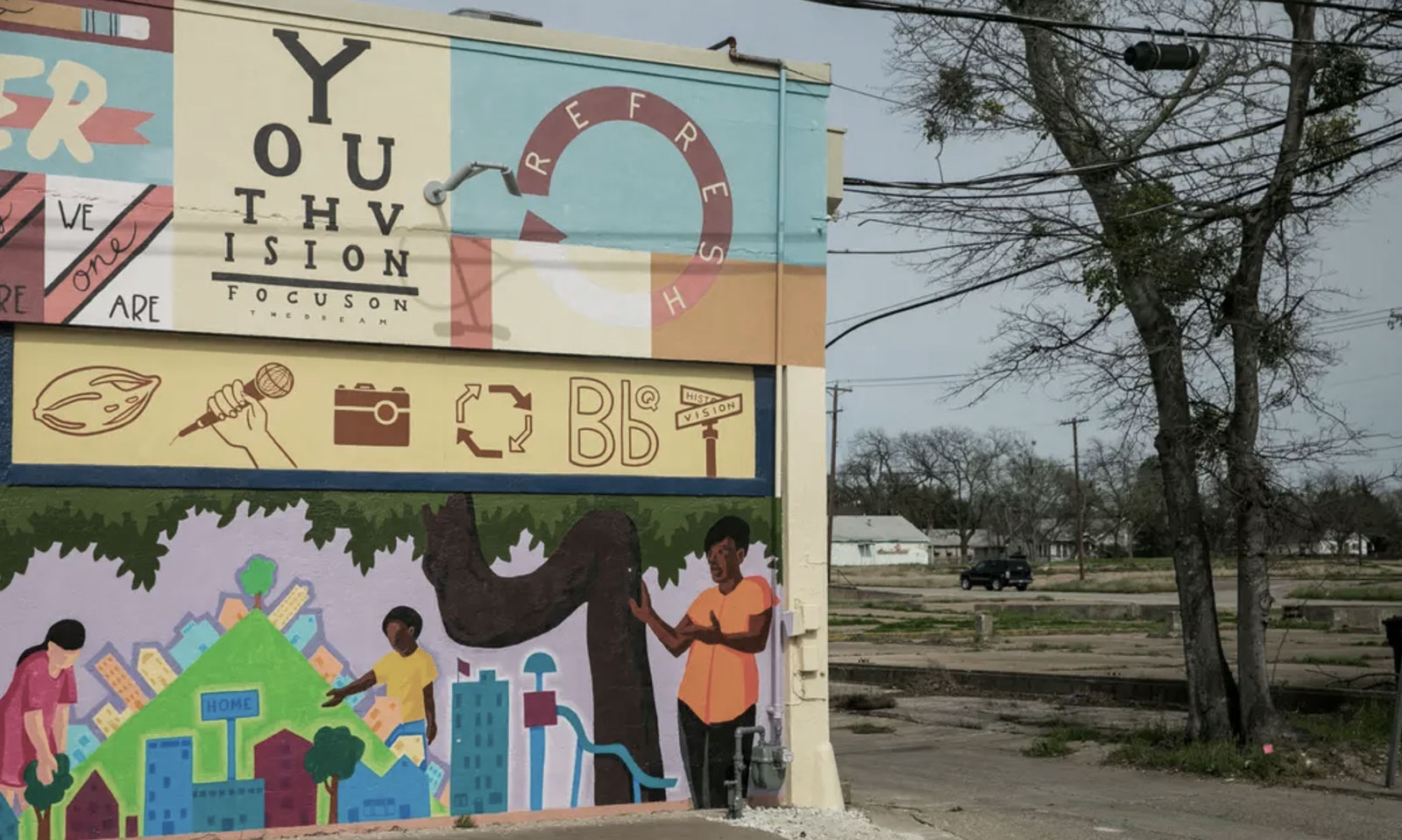

6. “Unfixing Up” Waco’s Identity
Magnolia ain't Waco, Texas.
Waco’s huge wave of development in recent years goes far beyond the cute Magnolia-ified shops downtown. There’s also the “shotgun” house two blocks away from the Silos, price tag just under $1 million for “business potential.” There are the three hotels slated for construction in East Waco on the edge of the stadium, the 941-square- foot lofts selling for $240,000 downtown, and the success of “Art on Elm Avenue,” which highlights the vibrancy of East Waco and its residents.
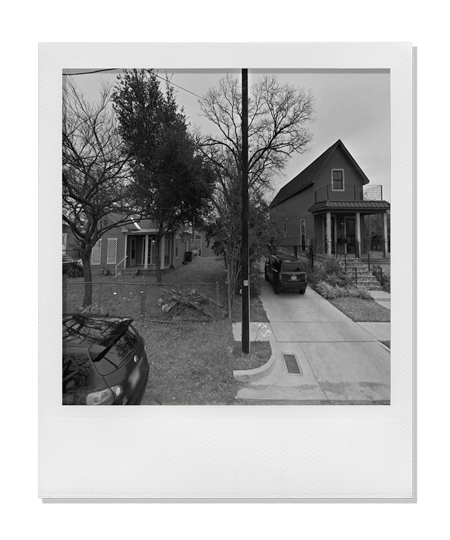
But development also takes the form of a retrofitted CrossFit gym sticking out like a sore bougie thumb on Elm Avenue. It’s not that people in East Waco don’t want new businesses to open, or new buildings to go up. They just don’t want development that isn’t, in any meaningful way, for them — and that shows up without warning.
“We don’t have a clue what’s going on until it pops up in the paper,” Pat Chisolm-Miller, who was recently elected county commissioner, told zoning representatives at a community meeting last September. “And that should not be, because we have the eyes and ears of this community.” The 200 people who showed at that meeting had seen what happened with the CrossFit gym. They’d heard about the new hotels. And their request wasn’t to stop development; it was to be part of it.
“No one’s saying, ‘Don’t grow,” Barefield, the city council member who represents a district that includes East Waco, told me. “But you have to do it intentionally, and thoughtfully — and through a lens that acknowledges the layers of systemic racism that led us to this moment. How the government controlled which types of people got access to houses, to business ownership, to everything. You have to unpack all that, understand all that. And don’t be offended if I don’t trust you.”
Over the last five years, Nancy Grayson has shown that development doesn’t have to happen to a community, but can happen with them. In 1998, Grayson launched Rapoport Academy, a charter school intended to counter the dismal testing scores in the East Waco. The school grew from 16 students to over 800, expanding to three schools on the former campus of Paul Quinn College. Grayson was named “Wacoan of the Year” in 2010, but resigned from her position as superintendent shortly thereafter — not to retire, but to fight social injustice in other ways.
“I love East Waco,” she told Waco Magazine. “I want to see East Waco come alive again in all ways. Maybe I should rephrase that — it’s already alive. But how can we help it emerge to its full potential for the people in East Waco? My fear is that East Waco will be renovated or repurposed in a way that excludes the community. That’s not my goal.”
“It’s not that people in East Waco don’t want new businesses to open, or new buildings to go up. They just don’t want development that isn’t, in any meaningful way, for them — and that shows up without warning.”
In 2012, Grayson opened the bakery Lula Jane’s on Elm Avenue, with fresh pies on Thursday and free coffee on Monday for old-timers who come to play dominoes. Grayson, with her distinctive overalls and handkerchief, is a regular feature behind the counter. Earlier this year, Grayson also purchased a church just down the street, intending to turn it into a place that sells the fresh food East Waco residents currently have to drive two miles to find at the nearest grocery store. The owner of the building had previously been hesitant to sell, but selling to Grayson was different.
“We felt she already has established Rapoport and was established in the community,” Tim Knight, the son of the owner, explained. Grayson is also building a set of small cottages behind Lula Jane’s, designed to fit in with the neighborhood. “We looked at what builds strong neighborhoods rather than great-looking boxes to live in,” she said. “I would like for any developer to start thinking in terms of strengthening neighborhoods rather than just building houses.”
“Development has a ripple effect, and I don’t want to see gentrification where people are displaced from homes their families have had for generations,” Grayson told Baylor Magazine. Attitudes like hers, however, are vanishingly rare. “People will still say to me, ‘Oh, East Waco? When I was in high school, we went over there to film an apocalypse movie,’” one resident told me, shaking her head.
“There are so many old preconceptions of East Waco — that’s it’s dangerous, that it’s whatever,” Cuevas Peacock, a community organizer with Grassroots Community Development, said. “I feel safer in East Waco than anywhere in town. I feel more empowered in East Waco than anywhere else. Which is why whoever is doing the development there, they need to be intentional. These communities, they’re used to being left out. It takes time to get people to trust that it might be different this time.”

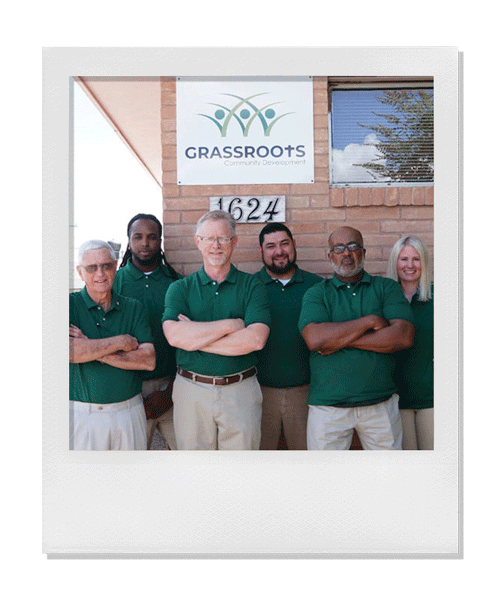
A mile away from Antioch, in North Waco, Grassroots has been “rehabbing” the neighborhood in a different way: not by moving in, but by working with low-income residents to help them buy and maintain homes in the area. In 2018, Grassroots helped repair 48 roofs, facilitated at least 16 home purchases, and helped build three new homes. “If you wanna go far,” executive director Michael Stone told me, “then you don’t go fast. You go together.”
Grassroots organizer Josh Caballero, who works specifically with North Waco, told me that business owners on 25th Street have also been watching downtown with a close eye. “These are small, family-owned businesses that have been around for decades,” he said. “They see the development downtown, and they wonder: How do we make sure that we preserve our community amidst that development?” Development without displacement requires significant regulation and planning: Moves like designating “cultural districts,” like Calle 24 in San Francisco, could protect current ownership structures.
But can development like that — which values the community for what it is, not just for the land it occupies — withstand, or even just coexist, with the Antioch attitude of “coming into a community and ministering to them and loving on them”?
“You know what that language is code for?” one resident asked me. “They want to come in and fix me. Fix us. But you know what? We’re not broken. Do we want to better ourselves and our circumstances? Of course. But that doesn’t mean we need fixing.”

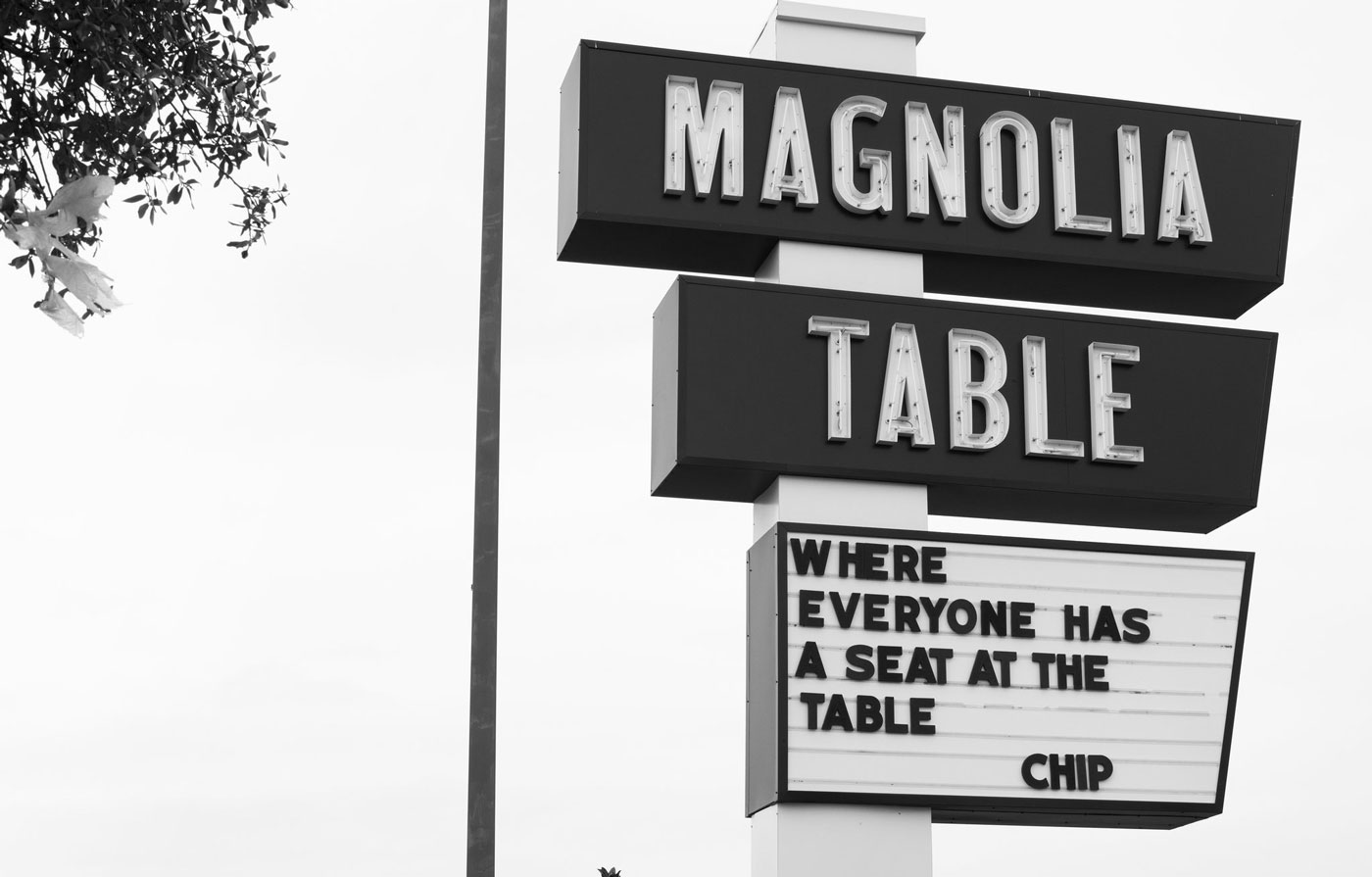

7. Old vs. New
"You can't fix a broken foundation until you acknowledge what caused the cracks in the first place."
There’s a narrative about Waco that I heard and read several times: that for hundreds of years, the town has been flat-out unlucky. The natural springs ran dry. Cotton was king, then the entire industry dried up. A widely publicized lynching gave it a bad name. The plans to become the state capital went awry. The tornado decimated the downtown. A cult set up shop 10 miles out of town. (“Those people, they weren’t even from here,” goes the general refrain. “They had nothing to do with us.”) A feud between rival biker gangs ended with nine dead in a 2015 shootout, but they, too, were from out of town. And what happened at Baylor — well, some would say that, too, was caused by outsiders.
Some of these events, especially the tornado, were indeed dumb luck. But others were described as “happenstance” (Texas Monthly) “a bump in the road” (the former sheriff), “challenges” (the local tourist magazine), “trials” (Joanna Gaines), or “just bizarre” (a Baylor graduate student). Within this figuration, Waco becomes passive: a place where things happen, not a city where the conscious decisions of its residents have wide-ranging consequences.
The natural springs ran dry through overuse. The cotton industry fell apart when it could no longer rely on slave labor or sharecropping. And the famous 1916 lynching known as the “Waco Horror” wasn’t a singular event — as one resident put it, “Jesse Washington wasn’t the only man, or woman, to swing.” (Historian William Carrigan has documented at least 21 lynchings in the area between Reconstruction and the Great Depression.)
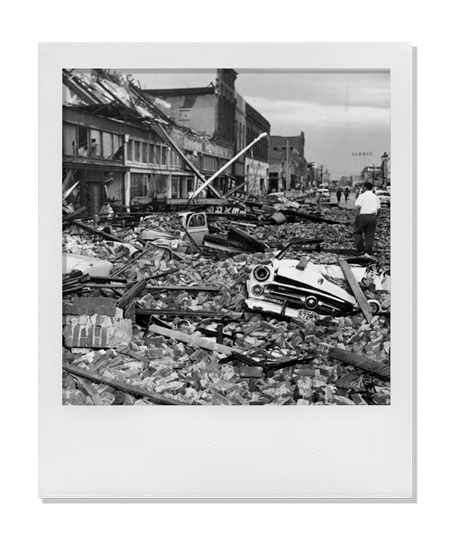
The 1953 tornado was a tragedy, but the downtown struggled to rebuild after it largely because of white flight — exacerbated by “urban renewal” policies. The bikers, like the Branch Davidians, were not from Waco — but the follow-up to the biker shooting, in which the police arrested an astonishing 192 people, sustained the years of coverage and lawsuits that followed; more than 100 bikers have sued the city for wrongful arrest. And the Baylor football scandal was the product of a culture, overlooked by university administrators, in which some students felt free to assault others without facing consequences.
“You can’t fix a broken foundation until you acknowledge what caused the cracks in the first place. You can’t rectify a history of exclusion without seeing the ways in which your hospitable city might still not be welcoming to all.”
That was the Old Waco, some might say — and this is the New, restored through hard work and time and grace and gleaming, freshly painted exteriors. But the thing about restoration is that the underlying structures — physical or institutional — remain intact. You can’t fix a broken foundation until you acknowledge what caused the cracks in the first place. You can’t rectify a history of exclusion without seeing the ways in which your hospitable city might still not be welcoming to all.
And there are many people in Waco — including members of Antioch— who are trying to think this way. Last year, Meek spoke for an hour at Antioch services, detailing the city’s history — of “restoration,” of course, but also of racism, discrimination, and poverty. “I want us to pray about what this history has to do with the predicament that this community finds itself in today,” he said. “People in our city aren’t intentionally racist, and I’m not trying to inflict shame on people when we talk about these subjects. But there are some realities that we have to face today — and I think we have to ask God: What are you calling for us to do?”
Conversations about gentrification — or what Antioch members call “restoration” — often pivot on the question of intent. If you don’t mean to push out members of a community that’s occupied an area for years, can you be blamed? If the intent is to “love on” a neighborhood by moving your church there, does it matter if the result is their displacement or disempowerment?
To consider development in terms of God’s plan can mean inoculating oneself from its consequences. What’s the response when someone can’t afford their property tax? When they’re frustrated that people call their family home a dump? When they feel like their whole life has been a string of white people deciding whether what they own is valuable, based solely on how much they want it? When it’s all God’s plan, that couldn’t be the result of a failure to collaborate with the community, or create policies that protect current residents. It’s no one’s fault.

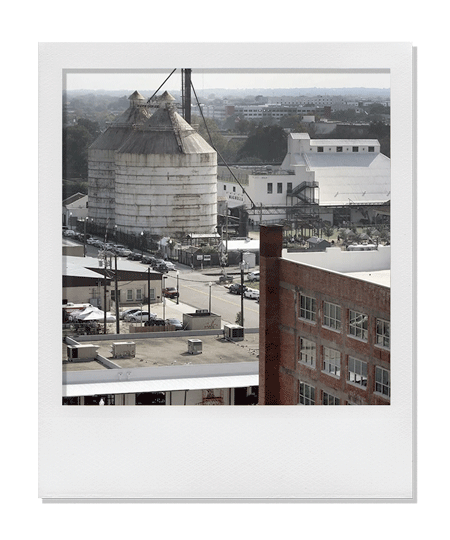
Ask anyone in town, from anywhere in town: Waco is a better place to live than it was 10 years ago. That’s not the question. The question is who will be able to live in that town in the years to come — and participate in it as homeowners, as entrepreneurs, as authorities on and within their own communities.
“Chip and Joanna, they really want to do the right thing for Waco,” one resident told me. “But that doesn’t mean there aren’t consequences that they couldn’t have foreseen.” When I visited Magnolia Market, the “Wow Wall” — which greets visitors when they first step into the building — was painted with a slogan: THE WORLD NEEDS WHO YOU WERE MADE TO BE. It’s a nice sentiment — one I saw dozens of customers Instagramming themselves in front of. And it reaffirms the entire premise of Magnolia, the entire posture of the New Waco, the entire thesis of “restoration.” All you need is a little fixing.

